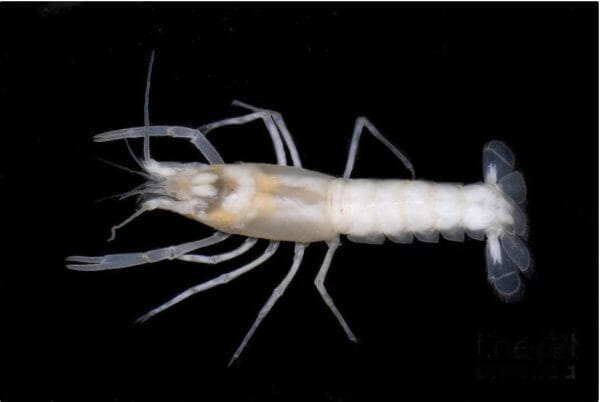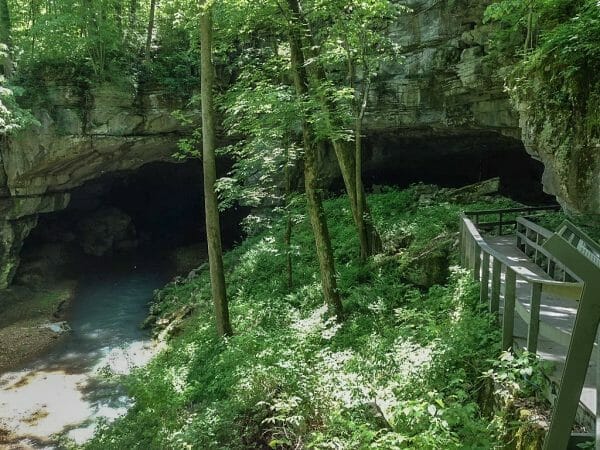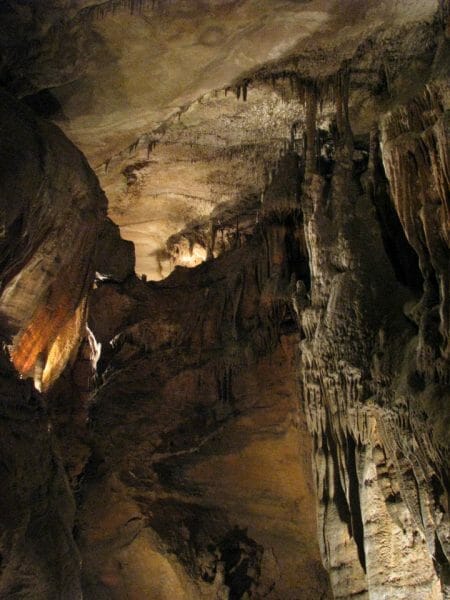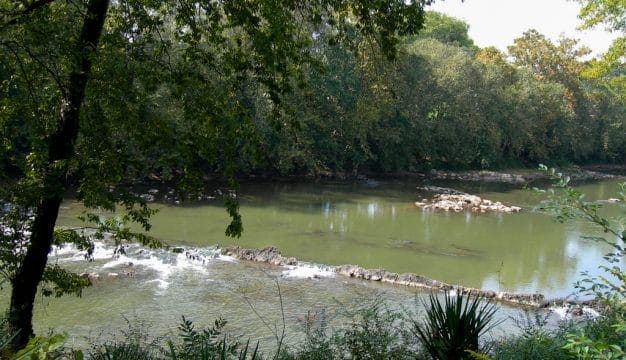Caves of Alabama
Alabama is home to a wealth of caves. In fact, northeast Alabama is considered a cave “hotspot” in the United States because of its many caves and the number of animals inhabiting those environments. This area contains approximately two-thirds of the state’s caves, but numerous other parts of the state possess the geology necessary for cave formation—beds of carbonate rock.
 Stalagmite Forest
Caves are geologic features that form in rock units known as karst, which result when slightly acidic rainwater erodes soluble bedrock. In karst areas, flowing water creates caves, sinkholes, and disappearing streams. Northeast Alabama is part of the “TAG” area, so named because it is a region of southeastern Tennessee, northern Alabama, and northwestern Georgia that is rich in karst geology. Caves in Alabama are found in three main regions: the Valley and Ridge section, which is part of both the TAG area and the southern reaches of the Appalachian mountain system; the Tennessee River Valley region, where the Tennessee River and its streams erode the carbonate rocks and create caves; and the Coastal Plain section, where people have discovered caves in the outcropping limestone beds. The Coastal Plain is home to the fewest number of caves in the state.
Stalagmite Forest
Caves are geologic features that form in rock units known as karst, which result when slightly acidic rainwater erodes soluble bedrock. In karst areas, flowing water creates caves, sinkholes, and disappearing streams. Northeast Alabama is part of the “TAG” area, so named because it is a region of southeastern Tennessee, northern Alabama, and northwestern Georgia that is rich in karst geology. Caves in Alabama are found in three main regions: the Valley and Ridge section, which is part of both the TAG area and the southern reaches of the Appalachian mountain system; the Tennessee River Valley region, where the Tennessee River and its streams erode the carbonate rocks and create caves; and the Coastal Plain section, where people have discovered caves in the outcropping limestone beds. The Coastal Plain is home to the fewest number of caves in the state.
 Key Cave Pool
Many Alabama caves occur within Mississippian limestone that was deposited during the Carboniferous geologic period, between 350 and 320 million years ago, when much of what is now Alabama was covered by a shallow sea. This rock is water soluble, and so as slightly acidic groundwater makes its way into natural cracks and openings in the limestone, it dissolves the rock and creates caves. Some of the most notable physical characteristics of the cave environment are solution features and depositional features. Solution features, which are the result of the actions of water passing over the limestone bedrock, include cavities, pockets, chambers, and chimneys. Depositional features, or speleothems, often form the most spectacular scenery in caves. Flowstone appears as frozen waterfalls, stalagmites grow from the cave floor, and stalactites hang from the cave ceiling. These depositional features are the result of minerals crystallizing out of the flowing, percolating, and dripping groundwater in caves.
Key Cave Pool
Many Alabama caves occur within Mississippian limestone that was deposited during the Carboniferous geologic period, between 350 and 320 million years ago, when much of what is now Alabama was covered by a shallow sea. This rock is water soluble, and so as slightly acidic groundwater makes its way into natural cracks and openings in the limestone, it dissolves the rock and creates caves. Some of the most notable physical characteristics of the cave environment are solution features and depositional features. Solution features, which are the result of the actions of water passing over the limestone bedrock, include cavities, pockets, chambers, and chimneys. Depositional features, or speleothems, often form the most spectacular scenery in caves. Flowstone appears as frozen waterfalls, stalagmites grow from the cave floor, and stalactites hang from the cave ceiling. These depositional features are the result of minerals crystallizing out of the flowing, percolating, and dripping groundwater in caves.
 Blind Cave Crayfish
Alabama caves are not only important for their geologic features; they also create important ecosystems for unique animals adapted to the perpetually dark world. Cave-dwelling animals can be divided into four categories. Animals specifically adapted to live in the lightless world of caves are called troglobites, or stygobites if they live in water. Blind, pigmentless animals, such as certain types of crayfish, fish, and salamanders, fall into these categories. Animals that live in caves but have not adapted special features for cave life are called troglophiles or stygophiles. Salamanders, spiders, and other animals that do have color and sight belong in these groups. Animals that inhabit caves only at certain times are called trogloxenes or stygoxenes, with bats being probably the most famous members of this category. Finally, animals that live in caves accidentally, for example by being washed in with a flood or by falling in a hole, are called accidentals. Some of the most common animals from all the categories found in Alabama caves are crayfish, millipedes, spiders, fish, salamanders, and bats. In 2022, scientists sighted the Shelta Cave crayfish, feared extinct and not seen since 1988.
Blind Cave Crayfish
Alabama caves are not only important for their geologic features; they also create important ecosystems for unique animals adapted to the perpetually dark world. Cave-dwelling animals can be divided into four categories. Animals specifically adapted to live in the lightless world of caves are called troglobites, or stygobites if they live in water. Blind, pigmentless animals, such as certain types of crayfish, fish, and salamanders, fall into these categories. Animals that live in caves but have not adapted special features for cave life are called troglophiles or stygophiles. Salamanders, spiders, and other animals that do have color and sight belong in these groups. Animals that inhabit caves only at certain times are called trogloxenes or stygoxenes, with bats being probably the most famous members of this category. Finally, animals that live in caves accidentally, for example by being washed in with a flood or by falling in a hole, are called accidentals. Some of the most common animals from all the categories found in Alabama caves are crayfish, millipedes, spiders, fish, salamanders, and bats. In 2022, scientists sighted the Shelta Cave crayfish, feared extinct and not seen since 1988.
Alabama ranks third among all U.S. states in the number of troglobite species. Jackson County has more caves and species than any other Alabama county and more troglobite species than any other county in the continental United States. Because of the number of caves and animals living in them, northeast Alabama is the most important site in North America for cave fauna. Key Cave in Lauderdale County is home to what may be the rarest fish in the world: the Alabama cavefish, discovered in 1967. It is a stygobite found only in that cave and has adapted to its sunless world by evolving sensors where eyes would have been in its ancestral form to detect the vibrations of moving prey. With no need to maintain color as an environmental adaptation, the fish has also evolved to be albino. This cave, among others, is also home to the endangered gray bat, underscoring the importance of ecosystem protection in the management of endangered and threatened species.
 Russell Cave National Monument
Caves have played an integral part in human history in Alabama as well. Russell Cave in Jackson County holds 10,000 years of history, dating back to the Archaic period. Prehistoric peoples of Alabama used caves for shelter, and early European settlers also discovered their usefulness for shelter and for food storage. Because cave temperatures remain stable and cool throughout the year, they made ideal places for storing perishables such as milk. Caves also aided the war effort at different times in Alabama’s history. Prior to the War of 1812 and during the Civil War, potassium nitrate was mined in Alabama caves. This substance was used to make early forms of gunpowder. Guano (or bat droppings) was also mined from Alabama caves for use as fertilizer. During the atomic scares of the Cold War era, some Alabama caves were designated as fallout or emergency shelters and were stocked with emergency supplies. In addition to these utilitarian purposes, Alabamians have been using cave environments as entertainment for many years. In the late nineteenth century, Shelta Cave in Huntsville was the site of parties and underground boating. In the 1930s during Prohibition, Blount County was home to an infamous speakeasy in Bangor Cave, where wealthy patrons flocked to enjoy music, drinks, and gambling.
Russell Cave National Monument
Caves have played an integral part in human history in Alabama as well. Russell Cave in Jackson County holds 10,000 years of history, dating back to the Archaic period. Prehistoric peoples of Alabama used caves for shelter, and early European settlers also discovered their usefulness for shelter and for food storage. Because cave temperatures remain stable and cool throughout the year, they made ideal places for storing perishables such as milk. Caves also aided the war effort at different times in Alabama’s history. Prior to the War of 1812 and during the Civil War, potassium nitrate was mined in Alabama caves. This substance was used to make early forms of gunpowder. Guano (or bat droppings) was also mined from Alabama caves for use as fertilizer. During the atomic scares of the Cold War era, some Alabama caves were designated as fallout or emergency shelters and were stocked with emergency supplies. In addition to these utilitarian purposes, Alabamians have been using cave environments as entertainment for many years. In the late nineteenth century, Shelta Cave in Huntsville was the site of parties and underground boating. In the 1930s during Prohibition, Blount County was home to an infamous speakeasy in Bangor Cave, where wealthy patrons flocked to enjoy music, drinks, and gambling.
 Rickwood Caverns
Alabama is so rich with caves that the National Speleological Society (founded in 1941) relocated its headquarters to Huntsville in 1971, giving the state a central role in the study of cave environments. In 1955, only 300 caves were known. During the mid-1950s through the 1960s, however, interest in Alabama caves and in scientific exploration to discover and map these subterranean environments increased dramatically. According to the Alabama Cave Survey, as of 2007, more than 4,200 caves have been discovered in Alabama. Some of these discoveries, such as Majestic Caverns, Cathedral Caverns, and Rickwood Caverns, are open to the public and provide access to and education about the wonders and beauty of the subterranean world. Sequoyah Caverns recently closed owing to low numbers of visitors. Through efforts of the National Speleological Society and the Alabama Cave Survey, new cave discoveries are still being made, as are advancements in preservation. With care taken to protect groundwater, fragile cave ecosystems can be preserved. Because Alabama is a hotspot for such habitats, preservation in the area is of the utmost importance.
Rickwood Caverns
Alabama is so rich with caves that the National Speleological Society (founded in 1941) relocated its headquarters to Huntsville in 1971, giving the state a central role in the study of cave environments. In 1955, only 300 caves were known. During the mid-1950s through the 1960s, however, interest in Alabama caves and in scientific exploration to discover and map these subterranean environments increased dramatically. According to the Alabama Cave Survey, as of 2007, more than 4,200 caves have been discovered in Alabama. Some of these discoveries, such as Majestic Caverns, Cathedral Caverns, and Rickwood Caverns, are open to the public and provide access to and education about the wonders and beauty of the subterranean world. Sequoyah Caverns recently closed owing to low numbers of visitors. Through efforts of the National Speleological Society and the Alabama Cave Survey, new cave discoveries are still being made, as are advancements in preservation. With care taken to protect groundwater, fragile cave ecosystems can be preserved. Because Alabama is a hotspot for such habitats, preservation in the area is of the utmost importance.
Further Reading
- Boschung, Herbert T. “The Alabama Cavefish.” Alabama Heritage 80 (Spring 2006): 12-15.
- Culver, David C., and William B. White, eds. Encyclopedia of Caves. Amsterdam and Boston: Elsevier/Academic Press, 2005.
- Daniel, Thomas W., and William D. Coe. Exploring Alabama Caves. Tuscaloosa: Geological Survey of Alabama, 1973.
- Lacefield, Jim. Lost Worlds in Alabama Rocks: A Guide to the State’s Ancient Life and Landscapes. Tuscaloosa: Alabama Geological Society, 2000.



